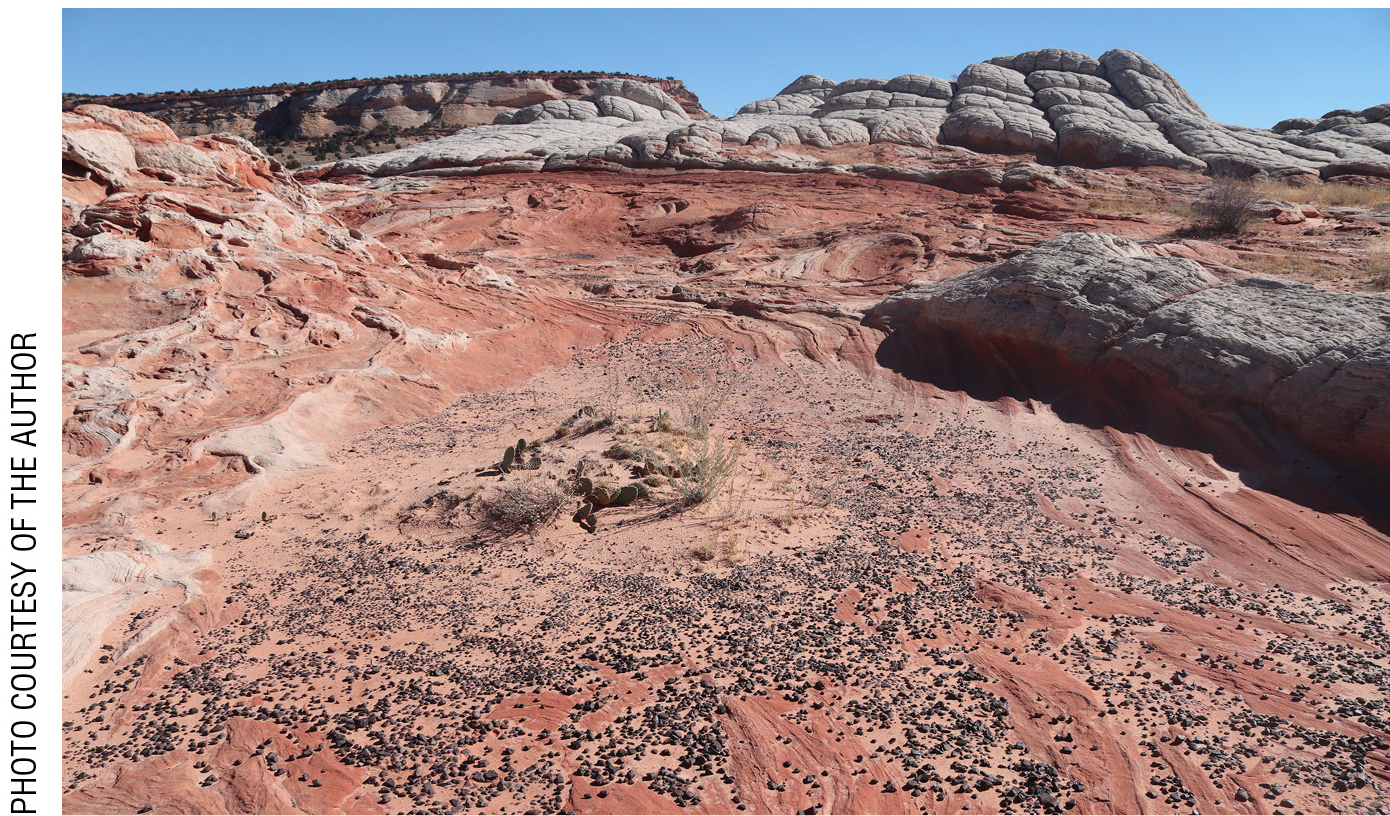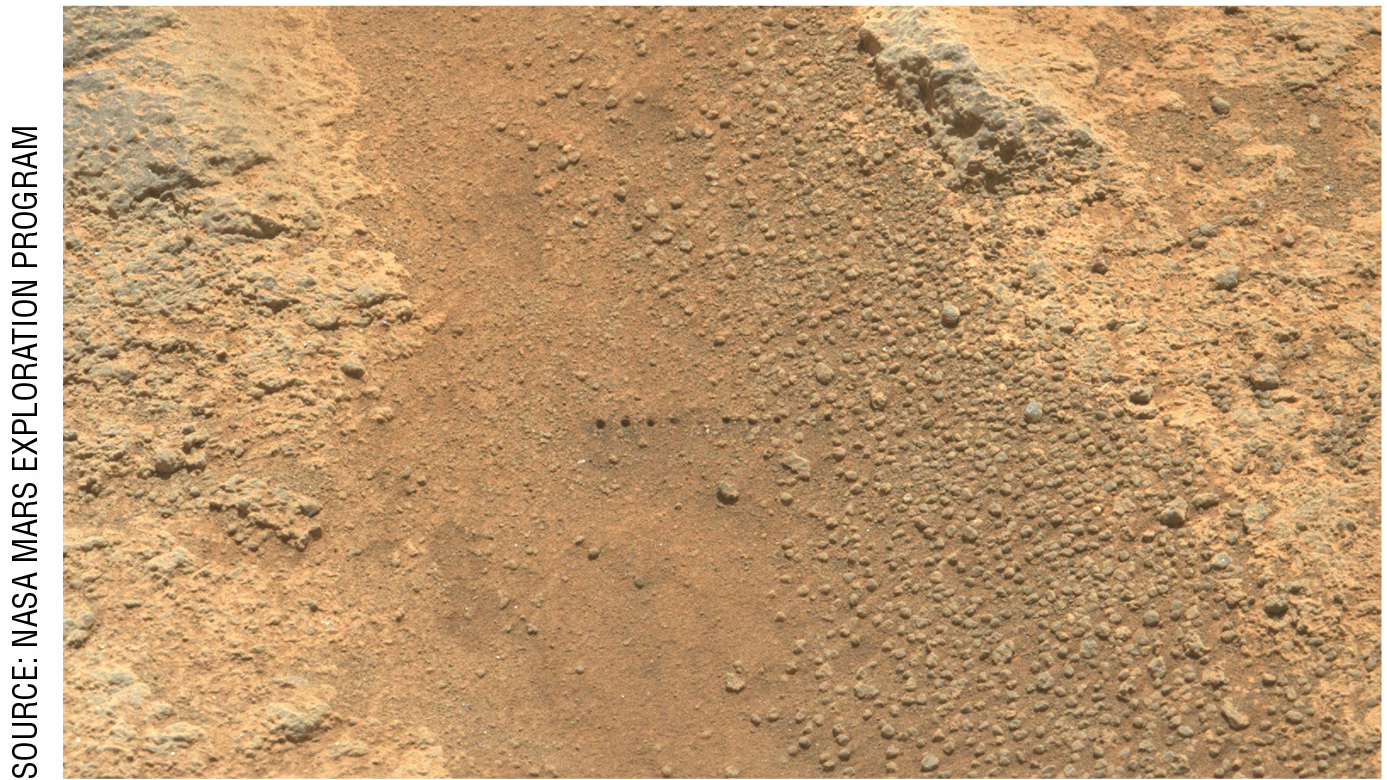scope on the skies
Where on Earth Is Mars?
The day is coming when a crewed mission sets down on Mars and becomes the second group of humans to be “boots” on another world. The first group consisted of 12 Apollo astronauts who landed and returned from our Moon. However, getting to Mars is more of a challenge, as we have learned from the numerous robotic missions sent to Mars over the years (see Online Resources). Challenges include everything from planning, designing, and building a spacecraft appropriate for the mission objectives to launch, interplanetary travel, and entering an orbit or landing and conducting a surface mission. Hopefully, not too many missions from now there will be a sample return mission, followed by additional round-trip robotic missions, and then the first crewed mission to Mars—one way or round trip?
In the meantime, there is plenty to do in preparation for a crewed mission to the “Red Planet.” There is still much to learn about how humans, using today’s technology, will cope with a seven-to-nine-month trip to Mars. If a return is planned, then the crew must be able to survive on Mars for two to three years before the next opportunity to return to Earth, and then the seven-to-nine-month voyage back. Additionally, the crew should be able to practice living and working in conditions similar to what they would experience on Mars. Although an indoor simulation is possible, it would be best to find places on our planet that are like places on the surface of Mars—those with little to no humidity, cold temperatures, sand, red rocks, and perhaps a high altitude to simulate the very thin Martian atmosphere. So where on Earth could we find Mars analogs, or Mars-like places?
The surface conditions on Mars that a crewed mission might experience depend on the location of their landing and the current Martian season. The latter is an important consideration because Mars has an orbital period almost twice that of the Earth, and Mars also has an elliptically shaped orbit, more so than the Earth’s orbital shape. The Martian year may include dust storms that encircle the globe and extreme ranges in temperature depending on which hemisphere, northern or southern (see Online Resources).
Welcome to Mars
The Atacama Desert in the South American country of Chile has been studied for several years as an analog to conditions on the Martian surface. The Atacama Desert is the driest desert in the world due to its location between the Andes and the Pacific Ocean and how that combination prevents moisture-laden air to rarely reach the desert. Mars has no ozone layer in its atmosphere, so the surface of Mars is unprotected from ultraviolet radiation from the Sun. In a similar way, the Atacama Desert receives UV radiation at a higher amount than any other location on the Earth (see Figure 1).

Atacama Desert
While the Atacama Desert climate is Mars-like, the one place on our planet that is most Mars-like is Devon Island, the largest uninhabited island on Earth. No one lives there permanently, however, because of the Mars-like surface conditions. Devon Island has hosted numerous Mars simulations involving living and working on Mars. Specifically, the Mars analog missions are conducted in Haughton crater, a 14-mile-wide (23-km) impact crater created by a meteorite approximately 23 million years ago during the Oligocene. Devon Island is located at approximately 80° north in Baffin Bay and is one of several islands belonging to the Queen Elizabeth Islands. Its elevation, its dry and cold air temperatures, as well as its rocky surface make the Haughton crater a realistic Mars analog, at least on Earth (see Online Resources).
It may be hard to picture Antarctica as ice free, but that is the case in an area west of McMurdo Sound known as the McMurdo Dry Valleys, a series of somewhat parallel valleys. This is an area of extreme conditions with very cold and very dry conditions, and with a rocky surface that has little to no snow and ice cover because of the surrounding mountains blocking any moisture-laden air from reaching the valleys. Like the Haughton crater area, the McMurdo Dry Valleys resemble the surface conditions on Mars. Unlike Mars, at least as far as we know, there is even bacterial life in the Dry Valleys.
Volunteers are being recruited for the Crew Health and Performance Exploration Analog, or CHAPEA. This is a NASA Mars analog program during which a crew of four will take part in a simulation of living and working for one year on the surface of Mars. Three of these analog missions are scheduled with the first mission during the fall of this year and one simulation each during 2024 and 2025. Each crew will operate as much as possible under simulated Martian conditions, including working outside the habitat. What is interesting is the planned use of a 3D printing system for building the parts needed for the habitats and many of the items needed within. Constructing with locally sourced materials like sandstone, and the use of the 3-D printer, would eliminate the need to ship a lot of construction materials and save launch weight as well. What would this be like, to print in 3-D the things you need? Coincidentally, SciFi author Kate Rauner has written a five-book series about colonizing Mars with a major part of the colonization and its future dependent on the use of 3-D printing technology (see Online Resources).
Got blueberries?
Want to go to Mars, or at least to a Mars analog that is not as remote as those previously described? You could go no further than the “red rocks” areas of the American Southwest in Southern Utah and Northern Arizona. There you will be surrounded by layers of Triassic age sandstone, geologically known as the Navajo Sandstone Formation. This was an arid area during the Triassic age located on the edge of the Pangaea supercontinent and covered by huge windblown, eolian sand dunes. Today this is a region of colorful layered rocks of pinks and reds that are the distinctive rock formations of the Grand Staircase–Escalante National Monument and other National Parks in Southern Utah. This is a desert-like area with canyons, multicolored rock layers. and vertical cliffs reaching heights of several thousands of feet. It is an area with hot and dry summers, and snow at higher elevations.
There is also a curious rock formations unique to the area that has a counterpart on Mars. These are locally known as moqui marbles and are hematite concretions—small roundish rocks that form as groundwater and other liquids leach out hematite. Later under certain conditions, the hematite will precipitate within the sandstone and over time bind sandstone grains together to form a concretion. Eventually as the parent rock weathers, these concretions may be released as roundish rocks—the moqui marbles. According to local guide Mike McTeer, the Hopi Indians, originally known as the Moqui, believed that the “marbles” were used by their ancestors when they came down to the Earth at night. They played games with the rocks, and at sunrise when they returned home, they would leave the marbles to show that they were okay (see Figure 2).

Earthly blueberries: “Moqui Marbles” at White Pockets Recreation Area.
NASA’s Opportunity rover, during its mission in 2004, found small roundish rocks that are similar in appearance to the moqui marbles and were nicknamed “blueberries” (see Figure 3). Believed to be also formed from the same processes, the Martian blueberries are mostly hematite whereas the moqui marbles largely consist of sandstone, with the hematite as the “cement” holding the sandstone together (see Online Resources).

Martian “blueberries.”
Take a ride—to heavy metal
NASA’s Psyche Mission to the asteroid Psyche is scheduled for launch during July of 2023, or possibly later. Although this mission was originally scheduled for launch during this past summer, there were some issues with the software needed to guide the spacecraft to the asteroid. Specifically, the software development has been completed, but the software has not been tested, and NASA has been hesitant to launch without the assurance that the software was good to go. Unfortunately, a delay such as this will mean that a new trajectory is required, and therefore it will take longer to arrive at asteroid Psyche as well as require more fuel.
The Psyche mission is scheduled originally for a 4-year trajectory following a path that takes it past Mars for a gravity assist a year after launch. After orbital insertion at the asteroid, the orbiter will spend the following 21 months conducting a series of experiments and observations. The mission timeline shows that the mission will end approximately one year later (see Online Resources).
For students
- How many countries or organizations have sent spacecraft to Mars? What is the total number of missions to Mars? How many were successful?
- Plan for a simulated mission to colonize Mars using materials from NASA’s Educator Guide: Mission to Mars Unit (see Online Resources).
- Picture yourself on Mars with the Mars Perseverance Photo Booth (see Figure 4).

The author on “Mars.”
Online Resources
Visible Planets November–December 2022— https://www.nsta.org/sites/default/files/journal-articles/Scope_NovDec_2022/visible_planets.pdf
Sky Calendar November–December 2022— https://www.nsta.org/sites/default/files/journal-articles/Scope_NovDec_2022/sky_calendar_Nov.pdf
Atacama Desert Offers Clues About Life on Mars—https://cnn.it/3CnQzCD
Atacama Landscape—https://go.nasa.gov/3SRqkM8
“Back to Mars.” Science Scope, Scope on the Skies. Bob Riddle. July/August 2020.
Dry Valleys, Antarctica—https://go.nasa.gov/3g0YTAY
Educator Guide: Mission to Mars Unit—https://go.nasa.gov/3g0Yqic
“Getting to Mars.” Science Scope, Scope on the Skies. Bob Riddle. November/December 2011.
Glad You Asked: What Are Moqui Marbles?—https://bit.ly/3RR8FTw
Haughton-Mars Project (HMP)—www.marsinstitute.no/hmp
Kate Rauner: Colony on Mars, 5-book series—kateraunerauthor.wordpress.com/
Mars on Earth: FYBR & NASA Haughton-Mars Project video—https://bit.ly/3CpCK6L
Mars on Earth: 7 Places That Look Like the Red Planet—https://bit.ly/3CP9p7m
Mars Perseverance Camera—https://go.nasa.gov/3VbV0ZU
Mars Perseverance Photo Booth—https://go.nasa.gov/3Ez2CA2
Martian ‘Blueberries’—https://go.nasa.gov/3RMsJWY
Martian Climate—en.wikipedia.org/wiki/Climate_of_Mars
Martian Year—https://go.nasa.gov/3eltQiD
Missions to Mars—https://bit.ly/3elult1
NASA’s Analog Missions—https://go.nasa.gov/3rM9DFT
NASA PYCHE Mission—psyche.asu.edu/
Partial Solar Eclipse—https://bit.ly/3rKllRl
Rove Around “Mars on Earth” in Street View—www.blog.google/products/earth/rove-around-mars-earth-street-view/
Teaching Roundtable with Seasons on Mars—https://bit.ly/3CwDkzU
Total Lunar Eclipse—moonblink.info/Eclipse/eclipse/2022_11_08
“The Red Issue.” Science Scope. Bob Riddle. September/October 2020.
White Pockets Trailhead—www.blm.gov/visit/white-pocket-trailhead
White Pockets Tour—https://bit.ly/3fYfWnb
Bob Riddle (bob-riddle@currentsky.com) is a science educator in Lee’s Summit, Missouri. Visit his astronomy website at https://currentsky.com.
Astronomy Earth & Space Science Middle School


